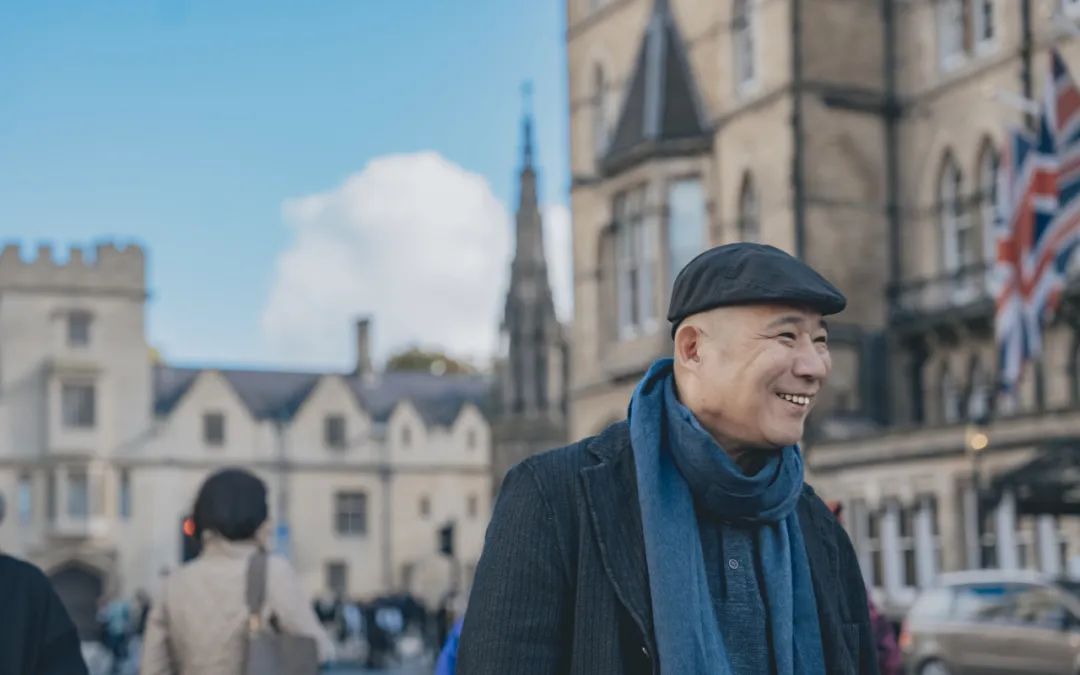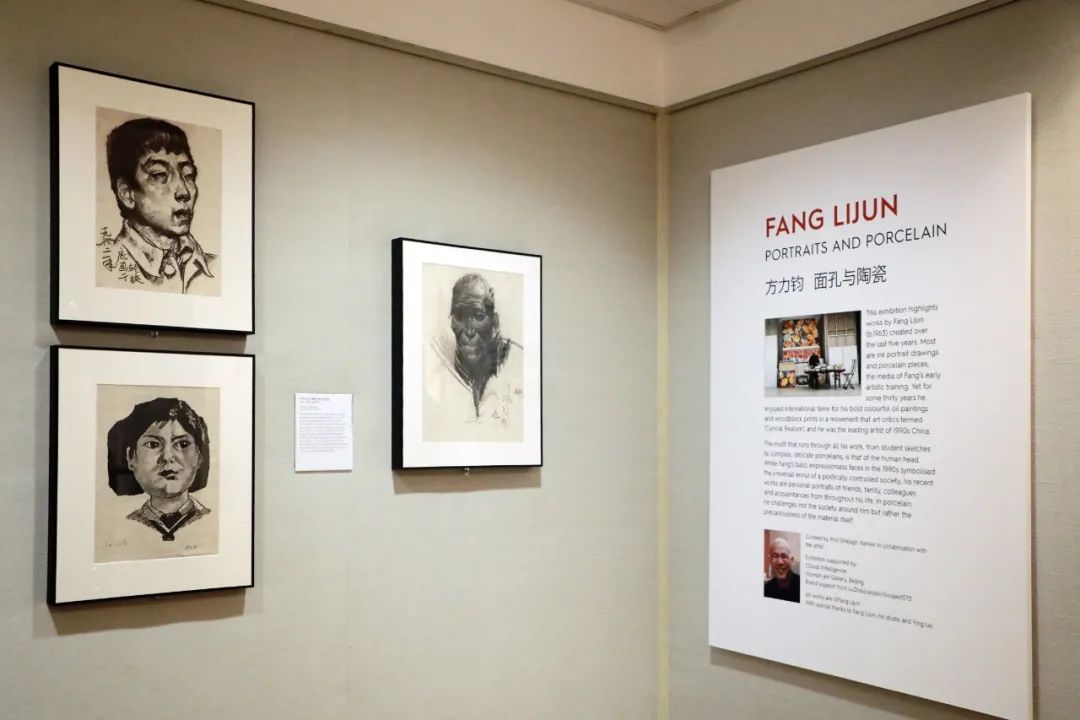Fang Lijun: Portraits and Porcelain, the Flow Between Constancy and Change
Interview / 99 Art
The Ashmolean Museum Oxford is known as The Ashmolean Museum of Art & Archaeology, the first public museum in the UK and one of the world's largest and most extensive university museums. The museum was the first public museum in Britain and one of the earliest public museums in the world, as well as one of the largest and richest university museums in the world. Its formation marked the birth of the modern museum. From October 15, 2023 to April 14, 2024, Fang Lijun's solo exhibition "Faces and Ceramics" will be held at the historic museum.
The exhibition presents works by the artist from the late 1970s to the present, covering oil painting, ink and wash, printmaking, and ceramic sculpture. These creations, spanning several decades, do not simply dwell on various attempts at changing media, but point to the core of Fang Lijun's longstanding thinking, and as curator Prof. Shelagh Vainker, Associate Professor in Chinese Art, Faculty of Asian and Middle Eastern Studies, University of Oxford, puts it, "Together, these works present a centralized and recurring theme that has been a constant theme in the artist's investigations throughout his career -- the human head and the range of possibilities it expresses."
The preparation of "Portraits and Porcelain" has been a long process. Planning began about five years ago, before the epidemic began, but was put on hold in the middle of the process because of the epidemic. However, in Fang Lijun's view, the extended period of time also has a positive side, as many of the works were completed during or after the epidemic, and because of this, we see a more complete picture of Fang Lijun's creative career to this day.
In fact, at the beginning of the planning of this exhibition, there was no desire to show so many works, "This exhibition can be a slice for me, or a stage presentation, there are many possibilities. But the curator hopes to present a relatively complete creative journey of an artist. Therefore, we have selected the most important works of each period on the basis of matching with the space. In the last seven years or so, I have basically painted portrait heads, and the curators also hope to present this part of the work on a large scale. As far as materials are concerned, I am involved in Chinese painting, oil painting, printmaking and ceramics, which are all presented in the exhibition; finally, I have added the latest color-glazed ceramic works. Therefore, the overall spatial volume of this exhibition is relatively large, and the content of the works included is also very comprehensive." Fang Lijun said.
The title of the exhibition, "Portraits and Porcelain", corresponds to the theme and medium of Fang Lijun's works, which seems to point to the two sides of his creative career - constancy and change. From the expression of freedom and individuality in the 1980s, to the shift from self-existential experience to a focus on the collective reality of the living environment and state in the 1990s, to the current return to the individual and the insinuation of the spiritual condition of all living beings from the individual, the change in the social environment has brought about reflection on history and irony and criticism of the current situation, which has become an important thread in Fang Lijun's works. However, this thematic grandeur is not configured with grandiose scenes, compositions, or a serious and solemn aura, but is often infused into the viewer's understanding of the work through playful and witty techniques.
Fang Lijun's works are direct and poignant, rejecting pretense and fearless rhetoric. The grandeur of history is dismantled in Fang Lijun's works into mundane, even humble, subtle individuals, but this dismantling of the authoritative definitions of civilization also illustrates one of the truths of history - that although history is made by a few, everyone is a writer of history.
The ceramics in the exhibition title "Portraits and Porcelain" seem to point to a certain change in Fang Lijun's creative work. This change is not only in the medium, but also in the new understanding and expression of the subject brought about by the medium. Fang Lijun's working style is quite unique, as oil painting, ink painting, printmaking, and ceramic sculpture can be carried out in the same time line, while at the same time taking care of a lot of desk work. In Fang Lijun's view, this way of working inspires him to look at the possibilities that different media can extend in his creations from a comparative point of view: "If you do all these works at the same time, you will be especially clear about what the characteristics of each of them are, and in which direction you should go."
Another focus of this exhibition is to present the genesis and development of a complete body of ceramics in Fang Lijun's oeuvre. Compared to painting and printmaking, ceramics is a relatively rare medium in Fang Lijun's body of work. In order to give the audience a more direct understanding of Fang Lijun's thinking in the creation of ceramic sculpture, the exhibition does not just show the finished works, but presents a relatively complete site of ceramic works, from sketches, to experimental small drafts, to small and medium-sized works. "Site", in ceramic works, can also be understood as an artistic presence. In Fang Lijun's view, ceramics have a strong medium quality: exquisite but extremely fragile. This quality also corresponds to a critical state of life. This quality of ceramics, and its relationship to the representation of real life, is not a reflection like a mirror, which cannot capture the passage of time and the flow of life, but rather this genuine state of liminality, "a person standing on a cliff, with the possibility of beginning or ending." For Fang Lijun, who once described himself as "living like a wild dog," the expression of life and existence must be based on personal experience. Just as comedy is underpinned by tragedy, Fang Lijun's works, from the playful realism of his early baldness to the distorted ceramic faces that have been squeezed to the point of distortion, are also interpretations of the tipping point of the existential situation. Perfection and disintegration, and an obsessive devotion to the fluid state between the two, has also become Fang Lijun's longstanding aesthetic undercurrent.
As a traditional material and craft, there is usually a more solidified perception of ceramics. In Fang Lijun's view, the concept of ceramics is changing with the times. "Ceramics has more possibilities," Fang Lijun said, "When confronted with this material, when I don't look at it according to an inherent, sole standard, I find that I get the whole world." Fang Lijun drew an analogy, "I think it's a bit like a thousand horses crossing a log bridge. The world is actually very vast, but under the influence of inherent thinking, everyone often chooses to take the log bridge."
The surfaces that have been treated very smooth, the effect of flat paint, the scattered perspective, the wild and unrestrained lines ...... In interpreting the prints, Fang Lijun once said, "I refuse you to look in, I want to simplify it the most. I think modern society is different from the past. In the past, the audience's requirement was to look in, but modern people, with so much time constraints, I have to set the time when the painting produces its effect in the memory, and only allow you to memorize it, not to look at it."
Fang Lijun has also gone through several different stages in his exploration of ceramic sculpture.
Early on, Fang Lijun wanted to use ceramics to achieve a visual effect that at a glance gave the impression that a living being was being represented. "It was particularly lucky at that time that I used the stretching and layering between the porcelain clay and different glaze colors, which naturally became like human skin after firing."
This series of works is undoubtedly successful, but Fang Lijun's exploration of ceramics does not stop there, "I think this is not enough, too superficial, it is only the visual aspect of the like, it is imitation, but from the psychological level of interpretation, or weaker." When it comes to the medium of ceramics, Fang Lijun seems to be intentionally avoiding the "direct expression" that he is so comfortable with, "When the idea of the tipping point is reached, it must be pushed into 'existence and non-existence', 'Existence is that moment' in the essence of this state." In this phase of his work, Fang Lijun begins with semantics. He translates abstract imagery into figurative words: light, thin, empty, translucent, exquisite, fragile. These words can be viewed as symbols, which have no meaning in their own right in the creation of the work, but are transformed into concrete information and structures once they are given meaning. This process of transformation opens up new possibilities for Fang Lijun, so that in this phase of his work, his ceramic sculptures take on an abstract meaning and further open up the limits of the medium itself.
Contradictions and oppositions are always present in all aspects of these ceramic sculptures, and they always seem to suggest that disintegration exists not only in art, but also in reality. "For every exhibition, we have to ship more pieces because it might have been destroyed during transportation. This one is normal destruction, no accident, no intention. In the past ten years or so, we've improved the packaging countless times, but we still can't avoid the damage. But the reason I call it a 'normal' destruction means that I already know this risk factor exists, so it stops being a tipping point and becomes pretty much a sure thing. That means it needs to keep pushing towards the edge of the cliff, which is an almost endless process, but there are times when it pushes too far and fails completely."
Returning to the exhibition itself, when asked what kind of feelings he had in the face of more than 30 years of creative journey, Fang Lijun said, "I'm 60 years old this year, and I've done about 60 solo exhibitions before, and this is the first solo exhibition I've done in a public institution in the UK, which is a milestone for me. Looking back at my creation and exhibition experience, I think it's like climbing stairs, or more like walking, step by step." |
 |






